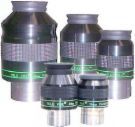The Best Nebula Eyepieces
Jack Kramer
When setting out to observe a nebula, we normally reach for our favorite deep sky eyepiece. But that may not be the best choice for a faint, diffuse nebula. There are several factors involved, including a couple that I had never considered before. To begin with, there's the range of eyepiece focal lengths:
- In an eyepiece with too short a focal length, the image will be so dark that the amount of nebulosity you see will be seriously diminished.
- If you use too long a focal length, the sky background may be so light that the image will be washed out.
Moreover, for faint nebulosity some veteran observers choose eyepieces with the fewest possible lens elements. For example, Barbara Wilson, a well-known deep sky observer in Texas, prefers the simple Plossl to the more complex eyepiece designs. Modern lens coatings greatly enhance light transmission even in eyepieces with 6 or more elements. But when searching out the very faintest nebulosity, many believe that fewer pieces of glass result in the best light transmission.
It never occurred to me though that the eyepiece exit pupil also could have a direct impact on how well you see a faint nebula. The term exit pupil refers to the image of the telescope's objective that is formed by the eyepiece - in simplest terms, the diameter of the light cone that strikes your eye at the point of best focus. To calculate the exit pupil, divide the eyepiece focal length by the telescope's focal ratio. If the pupil of your dark-adapted eye expands to 6mm (average for a fifty-year-old person) and the eyepiece presents an exit pupil of 8mm, you may see distortion that manifests itself as bloated star images. You're also wasting light, which diminishes the apparent surface brightness of the nebula.
Now here's where it becomes a bit complicated. More often than not we also use a "nebula" filter of some sort. And each type of filter works best within specific exit pupil ranges. Lumicon, a major supplier of filters, has published a breakdown of the optimum exit pupils for each of its filters. According to Lumicon:
As filter bandpass decreases, optimum exit pupil size tends to increase. To determine the best eyepiece focal length to use with a given filter, simply multiply the Exit Pupil value (in the table shown here) by your telescope's focal ratio. For example, if you are using the Lumicon H-Beta filter at a dark site and your telescope has an f/6 focal ratio, the best range of eyepiece focal lengths to use with this filter is ([4 to 7] x 6) = 24mm to 42mm.
While the following exit pupil values refer to Lumicon filters, they probably are close to comparable filters produced by other firms. The bandpass specs are the determining factor. As an example, the Orion UltraBlock filter has specs that closely match the UHC.
| Filters> | Deep Sky | UHC | OIII | H Beta |
| Bandpass | 90nm | 22-26nm | 10-12nm | 8-10nm |
| Exit PupilLight-polluted sky) | 0.5-2mm | 1-4mm | 2-5mm | 3-7mm |
| Exit Pupil(Dark sky) | 1-4mm | 2-6mm | 3-7mm | 4-7mm |
The proof of Lumicon's guideline is how well it applies in actual use. So I conducted an experiment using my 12-inch, f/4.9 scope on the Rosette Nebula (NGC 2237), which is very large and faint enough that it usually doesn't pop right out at you. Although my back yard isn't what I'd call dark, the worst light pollution is pretty much confined to one area, and the Rosette happened to lie in a darker region. So with the UHC filter I opted for the dark sky exit pupil limits, giving an eyepiece focal length range of 9.8mm to 29.4mm. I tried the UHC and UltraBlock for these tests because they are the most widely used of the narrowband filters. But my experience is that the Rosette seems to respond at least as well, if not better, with an OIII filter. Here are results from a representative sample of my eyepieces:
40mm Pentax XL - [2" Orion UltraBlock] too large an exit pupil but brighter portions of Rosette are just visible
27mm Tele Vue Panoptic - [2" Orion UltraBlock] patches of nebulosity are somewhat easier to see
19mm Tele Vue Panoptic - [11/4" Lumicon UHC] just about the entire nebula can be seen encircling the central star cluster
12mm University HD Orthoscopic - [11/4" Lumicon UHC] at first harder to see the nebula because of the narrower field, but after observing awhile it became easier, with narrow tendrils of nebulosity also visible
10mm Tele Vue Radian - [11/4" Lumicon UHC] nebulosity still visible but with less detail than the Ortho
 6.8mm Meade Ultra Wide Angle - [11/4" Lumicon UHC] very little nebulosity visible
6.8mm Meade Ultra Wide Angle - [11/4" Lumicon UHC] very little nebulosity visible
So it seems as though the "sweet spot" does fall within Lumicon's exit pupil values. Moreover, the Orthoscopic eyepiece with only four elements beat out the others for detailed views of the faint nebula. Results also could be affected by differences between the UltraBlock and UHC filters, and other characteristics of the eyepieces.
Published in the September 2007 issue of the NightTimes




